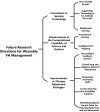Exploring the Potentials of Wearable Technologies in Managing Vestibular Hypofunction
- PMID: 39061723
- PMCID: PMC11274252
- DOI: 10.3390/bioengineering11070641
Exploring the Potentials of Wearable Technologies in Managing Vestibular Hypofunction
Abstract
The vestibular system is dedicated to gaze stabilization, postural balance, and spatial orientation; this makes vestibular function crucial for our ability to interact effectively with our environment. Vestibular hypofunction (VH) progresses over time, and it presents differently in its early and advanced stages. In the initial stages of VH, the effects of VH are mitigated using vestibular rehabilitation therapy (VRT), which can be facilitated with the aid of technology. At more advanced stages of VH, novel techniques that use wearable technologies for sensory augmentation and sensory substitution have been applied to manage VH. Despite this, the potential of assistive technologies for VH management remains underexplored over the past decades. Hence, in this review article, we present the state-of-the-art technologies for facilitating early-stage VRT and for managing advanced-stage VH. Also, challenges and strategies on how these technologies can be improved to enable long-term ambulatory and home use are presented.
Keywords: sensory augmentation; sensory substitution; vestibular hypofunction; vestibular management; vestibular rehabilitation; wearable devices.
Conflict of interest statement
The authors declare no conflicts of interest.
Figures





Similar articles
-
Developing a serious game for gaze stability rehabilitation in children with vestibular hypofunction.J Neuroeng Rehabil. 2023 Sep 26;20(1):128. doi: 10.1186/s12984-023-01249-x. J Neuroeng Rehabil. 2023. PMID: 37752531 Free PMC article.
-
Vestibular Rehabilitation for Peripheral Vestibular Hypofunction: An Updated Clinical Practice Guideline From the Academy of Neurologic Physical Therapy of the American Physical Therapy Association.J Neurol Phys Ther. 2022 Apr 1;46(2):118-177. doi: 10.1097/NPT.0000000000000382. J Neurol Phys Ther. 2022. PMID: 34864777 Free PMC article.
-
Effectiveness of virtual reality-based vestibular rehabilitation in patients with peripheral vestibular hypofunction.Turk J Med Sci. 2022 Dec;52(6):1970-1983. doi: 10.55730/1300-0144.5545. Epub 2022 Dec 21. Turk J Med Sci. 2022. PMID: 36945987 Free PMC article.
-
The role of sensory augmentation for people with vestibular deficits: Real-time balance aid and/or rehabilitation device?J Vestib Res. 2017;27(1):63-76. doi: 10.3233/VES-170606. J Vestib Res. 2017. PMID: 28387692 Review.
-
Gaze stabilisation exercises in vestibular rehabilitation: review of the evidence and recent clinical advances.J Neurol. 2019 Sep;266(Suppl 1):11-18. doi: 10.1007/s00415-019-09459-x. Epub 2019 Aug 5. J Neurol. 2019. PMID: 31385017 Review.
Cited by
-
The impact of bilateral vestibulopathy on quality of life: data from the Antwerp University Hospital registry.Eur Arch Otorhinolaryngol. 2025 Apr 16. doi: 10.1007/s00405-025-09369-x. Online ahead of print. Eur Arch Otorhinolaryngol. 2025. PMID: 40237789
References
-
- Perez Fornos A., Guinand N., Van De Berg R., Stokroos R., Micera S., Kingma H., Pelizzone M., Guyot J.-P. Artificial balance: Restoration of the vestibulo-ocular reflex in humans with a prototype vestibular neuroprosthesis. Front. Neurol. 2014;5:66. doi: 10.3389/fneur.2014.00066. - DOI - PMC - PubMed
-
- Burzynski J., Sulway S., Rutka J.A. Vestibular Rehabilitation: Review of Indications, Treatments, Advances, and Limitations. Curr. Otorhinolaryngol. Rep. 2017;5:160–166.
-
- Orlov I.V., Stolbkov Y.K., Gerasimenko Y.P. Vestibular Prosthetics: Concepts, Approaches, Results. Neurosci. Behav. Physiol. 2018;48:711–720. doi: 10.1007/s11055-018-0621-5. - DOI
Publication types
LinkOut - more resources
Full Text Sources
Miscellaneous

